Northwest Africa: 2017/18 Crop Expectations Deteriorate Because of Unfavorable Spring Weather
 Morocco, Algeria, and Tunisia are net wheat-importing countries which experience large swings in production due to their semi-arid climate. The arable land in all three countries is concentrated near the coast and in the uplands, where precipitation is higher due to topography. This strip of arable land is quite narrow, reaching a maximum width of about 125 miles in central Morocco. In all three countries wheat is the preferred crop while barley is secondary and grown on more marginal land. Other field crops in Northwest Africa include fava beans, sugar beets, rapeseed, sunflowerseed, and chickpeas. Olives, which are an important traditional crop, are grown in groves in the drier regions. About one quarter of Morocco’s wheat is durum, 40 to 50 percent for Algeria, and about 80 percent for Tunisia. Morocco, Algeria, and Tunisia are net wheat-importing countries which experience large swings in production due to their semi-arid climate. The arable land in all three countries is concentrated near the coast and in the uplands, where precipitation is higher due to topography. This strip of arable land is quite narrow, reaching a maximum width of about 125 miles in central Morocco. In all three countries wheat is the preferred crop while barley is secondary and grown on more marginal land. Other field crops in Northwest Africa include fava beans, sugar beets, rapeseed, sunflowerseed, and chickpeas. Olives, which are an important traditional crop, are grown in groves in the drier regions. About one quarter of Morocco’s wheat is durum, 40 to 50 percent for Algeria, and about 80 percent for Tunisia.
Analysts from the USDA Foreign Agricultural Service (FAS) conducted crop-assessment travel in Morocco and Tunisia during late March and early April 2017. The team met with producers, traders, agricultural officials, and industry representatives, and examined crop conditions at key stages of development. In the field they collected geographic data observations for use in classifying land cover and crop types. Several thousand points were recorded, to be used as training data in combination with Landsat imagery to classify the arable regions in Northwest Africa. By taking advantage of cloud computing programs like Google Earth Engine, the finished products were finalized in just a few days after the team returned to USDA Washington. These data products can be used to identify crops of interest and determine an experimental area estimate.
 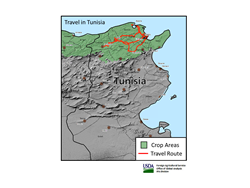
Cropland Classification Results:
Click on Image for larger version.
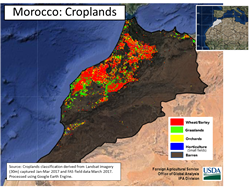 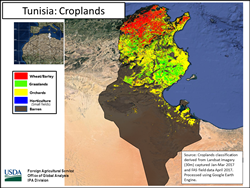
Morocco
Winter-crop planting was delayed one month because autumn rains arrived later than normal. Instead of the usual November arrival, steady rains began to fall in December and continued through mid-February. Farmers rapidly seeded fields in December and January, and although planting occurred somewhat later than the optimal time period, it was still in time for proper establishment. Morocco’s winter grains do not become fully dormant, so beneficial winter moisture enabled the late-planted crops to emerge and become well established. Dryness returned in mid-February, intensifying into drought conditions in March and April. Despite the lack of rainfall in both early fall and spring, Morocco’s 2017/18 wheat crop is estimated to be significantly higher than last year’s crop, which suffered from severe drought. Conditions this season were largely favorable until the crops reached the flowering stage, which typically occurs during the end of March in the south and central regions, and early April in the northern areas.
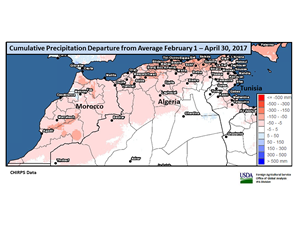
Dryness Dominated Northwest Africa from Mid-February through April
Cumulative Rainfall by Country (click on country below for graph)
Winter wheat and barley were observed to be in good or very good condition during late March. Although rainfall had diminished, good soil moisture sustained crops until April. Many analysts, assuming additional rainfall, expected bumper crops throughout Morocco, including in the more marginal production areas in the south. Further rain, however, did not occur so dryness began to dominate in March and April while crops were flowering and at early grain fill. It is at this stage that they are most vulnerable to dryness. Dryness intensified into drought conditions, triggering a rapid dry-down that shortened the growing season by approximately one month. The heat and lack of moisture resulted in smaller kernels and lower yields. The pictures below show the rapid change in the area around Meknes, north-central Morocco, in just three weeks.
Near Meknes, Morocco March 31, 2017 Near Meknes, Morocco; April 20, 2017  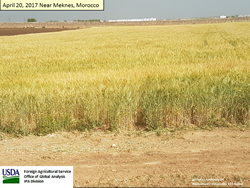
Please click on picture for a larger image.
Although conditions in the south were already noticeably dry by the end of March, the abundant winter precipitation reduced the impact of the spring deficit. Conditions in the northern and central areas were favorable longer, until the end of April. Typically, southern Morocco (the area around Marrakech) is drier than regions further north or along the coast (like Rabat and Casablanca), and drier than in the elevated areas near Fes and Meknes which typically receive more precipitation due to their topography. High temperatures and dryness accelerated crop development and enabled harvesting in the south to begin in April, which is extremely early.
Seasonal NDVI graphs depict conditions in Northern and Southern Morocco.
Please click on graph to enlarge.
 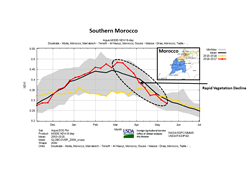
Satellite-derived NDVI anomaly maps (below) reflect excellent early-season conditions in February and the impact of the heat and dryness on crop development in April. The crop in mid-February (depicted as green), is lush and vigorous in the first image. Afterwards, dryness began in mid-February and lasted through May. It is evident from the bottom image (early April), that the crop was rapidly drying down with better than normal vegetative conditions in Morocco and Tunisia, but worse than normal conditions in Algeria. Further imagery in May (not shown), depicts the crop in all of Northwest Africa having prematurely advanced to harvest and early senescence, thereby reducing yield.
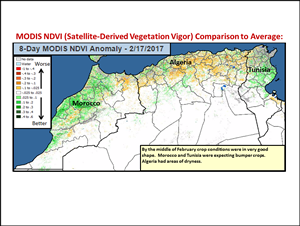
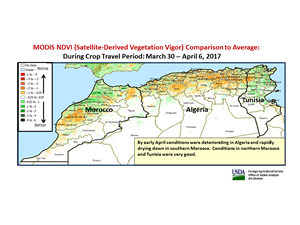
USDA estimates Morocco wheat production at 5.8 million tons, more than double last year’s 10-year low of 2.7 million metric tons (mmt) and 9 percent above the 5-year average. Yield is estimated at 1.76 tons per hectare (t/ha), similar to the average yield. Barley production is estimated at 2.0 mmt from an estimated harvested area of 1.8 mha, with an estimated yield of 1.11 t/ha, making this a near-average crop.
Tunisia
Conditions in Tunisia were very favorable until early April due to frequent and adequate rainfall. Good planting weather last autumn combined with increased State support, including higher guaranteed farm-gate prices, led to increased area. Conditions deteriorated rapidly, however, with dryness beginning about mid-February and lasting throughout March and April. Tunisia’s cropping season tends to be later than in Morocco because of a cooler climate. Wheat production in Tunisia for 2017/18 is estimated to be about average at 1.2 mmt with a slightly lower-than-average yield of 1.94 t/ha. Durum wheat comprises the majority of total wheat grown in Tunisia. The FAS team observed wheat to be in good condition in early April, but imagery depicts a rapid decline in crop conditions beginning in mid-April.
Barley production for Tunisia is estimated at 0.5 mmt from an area of 0.4 mha with a yield of 1.33 t/ha. Both yield and production are near average. Barley is harvested in May and wheat is harvested in June and early July.
NDVI indicates a rapid decline in crop conditions beginning in April.

Algeria
Similar to the other countries in Northwest Africa, Algeria had rainfall deficits in October and November, but unlike Morocco and Tunisia most of the country did not benefit from abundant winter precipitation. Algeria received low rainfall amounts throughout most of the season, particularly in the larger grain-producing region in the east. Precipitation was most favorable in the central coast, where near-average amounts fell during the season. Satellite imagery indicates a rapid deterioration in crop conditions throughout the country during April. Wheat production and yield for 2017/18 are estimated below-average at 2.5 mmt and 1.19 t/ha. The barley crop is estimated at 1.2 mmt from an area of 1.0 mha and a 1.26 t/ha yield, which is 12 percent below the 5-year average production level and 9 percent below the 5-year average yield.
NDVI seasonal graphs of Algeria’s cropland regions:
Please click on region to enlarge graph.
Western Algeria Central Algeria Eastern Algeria
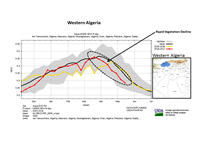 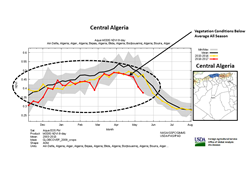 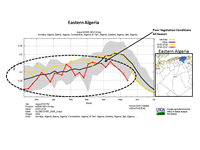
USDA estimated area, yield and production of wheat by country:
Please click on the country name to enlarge graph.
Morocco Algeria Tunisia
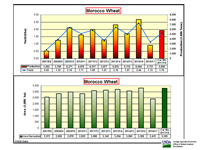 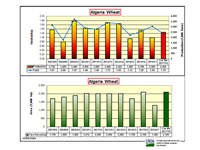 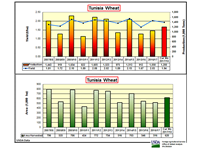
Valuable contributions for this report from FAS-Rabat and FAS-Tunisia are gratefully acknowledged. For additional information please see USDA-FAS reports on Morocco, Algeria, and Tunisia. These reports provide local assessments of agricultural conditions from our posts overseas but are not considered official USDA estimates. Official USDA estimates can be found at PSD Online.
Current USDA area and production estimates for grains and other agricultural commodities are available on IPAD's Agricultural Production page or at PSD Online.
Visit Crop Explorer http://www.pecad.fas.usda.gov/cropexplorer/
|

